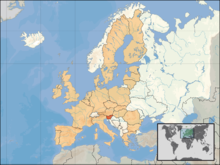Atlas of Slovenia
Specific status: Akrotiri and Dhekelia‡ · Faroe Islands · Gibraltar · Bailiwick of Guernsey · Isle of Man · Jersey · Svalbard – Limited recognition: Abkhazia‡ · Gagauzia · Kosovo · South Ossetia‡ · Transnistria · Northern Cyprus‡
‡: partly located in Europe

|
Wikimedia Commons Atlas of the World The Wikimedia Atlas of the World is an organized and commented collection of geographical, political and historical maps available at Wikimedia Commons. Discussion • Update the atlas • Index of the Atlas • Atlas in categories • Other atlases on line |
|
| ||||||||||||||||||||||||||||||||||||||||||||
General maps

|
Map of Slovenia |

|
Map of Slovenia in Slovenian |

|
Topographic map of Slovenia |

|
Map of Slovenia |

|
Map of Slovenia in the colors of the Flag of Slovenia. |

|
Blank map |

|
Blank map |

|
Statistical Regions |

|
Statistical Regions |

|
Municipalities of Slovenia |

|
Traditional regions |

|
Traditional historical regions |
History maps
This section holds a short summary of the history of the area of present-day Slovenia, illustrated with maps, including historical maps of former countries and empires that included present-day Slovenia.

|
Possible extent of (proto-)Celtic influence 800-400 BC Die Kelten in Europa. Ocker: Kernbereich Nordwestalpine Hallstattkultur (ca. 750–500/450 v. Chr.) grün: Ausbreitung La-Tène-Kultur, bzw. orange: der keltischen Sprache (3. Jh. v. Chr.) |

|
Territorial development of the Roman Empire 264 BC-192, including the conquest of present day Slovenia |

|
Roman Republic 100 BCE |
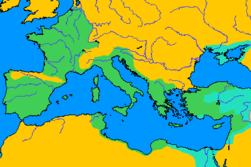
|
Map of the Roman Empire in 50 |

|
The extent of the Roman Republic and Roman Empire; 133 BC 44 BC (late Republic, after conquests by republican generals) AD 14 (death of Augustus) 117 (maximum extension)
|

|
Camps of the Roman Legions in 80 |
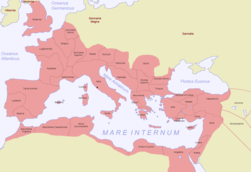
|
Map of the Roman Empire in 116 |

|
Noricum in the Roman Empire (116) |

|
Pannonia in the Roman Empire (116) |

|
Dalmatia in the Roman Empire (116) |

|
Roman Empire in 117 |

|
Territory of Slovenia within Roman Empire, 1-300 AD |

|
Roman Empire divided 395, showing the dioceses and praetorian prefectures of Gaul, Italy, Illyricum and Oriens (east), roughly analogous to the four Tetrarch zones of influence after Diocletian's reforms. |

|
The division of the Empire after the death of Theodosius I, ca.395 AD superimposed on modern borders. |
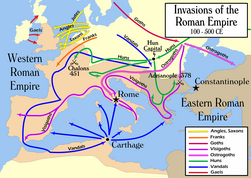
|
Invasions of the Roman Empire 100-500 |

|
Invasions of the Roman Empire 100-500 |

|
Division of the Roman Empire in 406 |
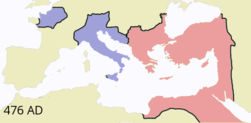
|
Eastern Roman Empire and Western Roman Empire, c.476 |
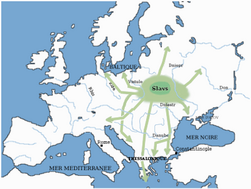
|
Migration of the Slavs, 5th-10th century |

|
Suabes in 550 AD |
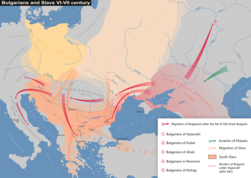
|
Slavic lands in Europe, 6th-7th century |

|
Slavic lands in Europe, 7th-8th century |

|
Tribal Kingdom of Samo, 631 AD |

|
Samo's Realm, 7th century |

|
Samo's Realm, 7th century |

|
Valuk's Carantania, 7th century |

|
Slavic lands in Europe in 700 AD |

|
Slavic lands in Europe, 8th-9th century |

|
Carinthia and Rise of the Frankish Empire, 8th-9th century |

|
Slovenian principalities in 800 |

|
Slovenian principalities in 800 |

|
Carniola around 800 |

|
Carantania in 800 |

|
Carinthia within Carolingian Empire around 800 |

|
Carolingian Empire (in French) |

|
Carinthia and Carniola in Europe in 814 Europa im Jahre 814 |
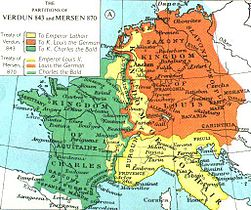
|
Carinthia during the Treaty of Verdun (843) and Treaty of Meerssen (870) |

|
Carinthia during the division of the Frankish Empire after 870 |
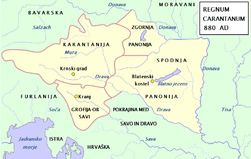
|
Carantania in 880 |

|
Frankish Lower Pannonia, 9th century |

|
Pannonian Slavic Duchy (Balaton Principality) in the 9th century |

|
Pannonian Slavic Duchy (Balaton Principality) in the 9th century |

|
Pannonian Slavic Duchy (Balaton Principality) in the 9th century |

|
Principality of Braslav in the 9th century |

|
Slavic lands in Europe in 900 |

|
Map of Karantania / Carinthia, 10th century |
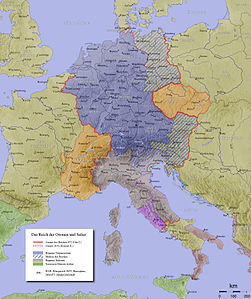
|
Marks of Carniola, Carinthia and Istria in the 10th century |

|
Carinthia and Carniola in Central Europe 919-1125 |
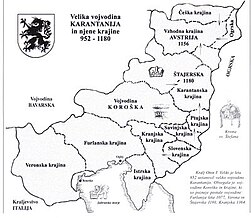
|
Great duchy of Carantania / Carinthia in 952-1180 |

|
Duchy of Carantania / Carinthia in 990 |

|
Carinthia in 1000 |
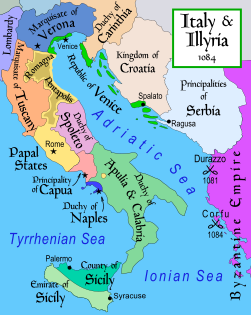
|
Carinthia in 1084 |

|
Czech Kingdom under king Přemysl II, 1253-1271 |

|
Styria, Carinthia and Carniola under Habsburgs, 13th-16th century |

|
Principality of Celje, 15th century |

|
Carinthia, Carniola and Styria in the map of the Holy Roman Empire and its circles in 1512 |

|
The (Habsburg) Empire of Charles I/V. Castile Aragon Burgundy Habsburg
|

|
Carinthia, Carniola and Styria in the (Habsburg) Empire of Charles I/V in 1547 |
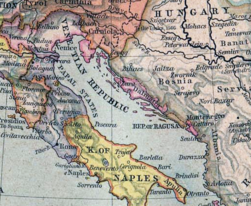
|
Carniola in 1560 |

|
The religious situation in central Europe about 1618 |
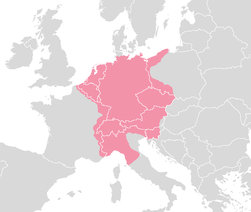
|
Area controlled by the Holy Roman Empire around 1630 |

|
Map of the Duchy of Carniola, Windic March and Istria in 1714 |

|
Illyrian Provinces of the French Empire in 1810 |

|
Illyrian Provinces of the French Empire in 1811 |

|
Illyrian provinces in 1811 |

|
Kingdom of Illyria in 1814-1815 |

|
Kingdom of Illyria in 1816 |

|
Austria inside the German Confederation |

|
Austria inside the Borders of the German Confederation in 1820 |

|
Kingdom of Illyria within Austrian Empire (1818) |
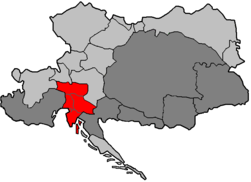
|
Kingdom of Illyria within Austrian Empire (1822-1849) |

|
Kingdom of Illyria within Austrian Empire (1822-1849) |
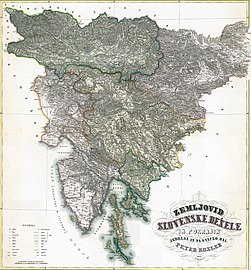
|
A view on United Slovenia (enlarged Kingdom of Illyria) in 1848 |

|
Slovenians in the ethnic map of Austria-Hungary, census 1880. German version |
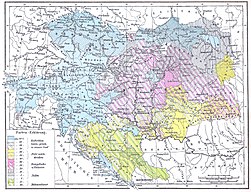
|
Religions in Austria-Hungary, Andrees Allgemeiner Handatlas, 1st Edition, Leipzig (Germany) 1881 |
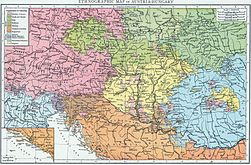
|
Slovenians in the ethnic map of Austria-Hungary, census 1890. English version |

|
Austrian Littoral and Carniola in 1897 |

|
Slavic lands in Europe in 1900 |

|
Historical map of Austria-Hungary from the Bibliothek allgemeinen und praktischen Wissens für Militäranwärter Band I, 1905 |

|
Proposed state of Carniola within the United States of Greater Austria in 1906 |

|
Proposed state of Carniola within the United States of Greater Austria in 1906 |

|
In 1867 the Austrian Empire was continued by Austria-Hungary, making both Austria and Hungary constituent monarchies. This is map of Austria-Hungary from 1913 |
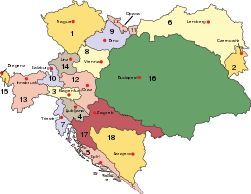
|
Kingdoms and countries of Austria–Hungary: Cisleithania: 1. Bohemia, 2. Bukovina, 3. Carinthia, 4. Carniola, 5. Dalmatia, 6. Galicia, 7. Austrian Littoral, 8. Lower Austria, 9. Moravia, 10. Salzburg, 11. Silesia, 12. Styria, 13. Tyrol, 14. Upper Austria, 15. Vorarlberg; Transleithania: 16. Hungary, 17. Croatia and Slavonia; 18. Bosnia and Herzegovina |

|
Austria-Hungary in 1914 |

|
Istria, Trieste and Gorizia in 1914 |

|
The end of Austria-Hungary (in German) |

|
State of Slovenes, Croats and Serbs in 1918 |

|
Republic of Prekmurje in 1919 |

|
Republic of Prekmurje in 1919 |

|
Kingdom of Serbs, Croats and Slovenes in 1919 |
| [[|border|251x400px]] | After World War I, Slovenia became part of the Kingdom of Serbs, Croats and Slovenes in 1918, which was renamed into Kingdom of Yugoslavia in 1929. This is a map of Kingdom of Yugoslavia in 1930, showing Drava banovina province |

|
Drava banovina in the Kingdom of Yugoslavia in 1929-1939 |

|
Drava banovina in the Kingdom of Yugoslavia in 1929-1939 |

|
Drava banovina in the Kingdom of Yugoslavia in 1929-1939 |
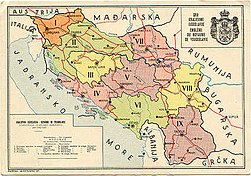
|
Drava banovina in the Kingdom of Yugoslavia in 1929-1939 |

|
Axis invasion of Yugoslavia in 1941 |

|
Triple occupation of Slovenia in 1941 |

|
Triple occupation of Slovenia in 1941 |

|
Occupation of Slovenia in 1943 |
| [[|border|251x400px]] | Triple occupation of Slovenia in 1941 |

|
Triple occupation of Slovenia in 1941 |

|
Triple occupation of Slovenia in 1941 |

|
Province of Ljubljana, 1941-1943 |

|
Province of Ljubljana, 1941-1943 |
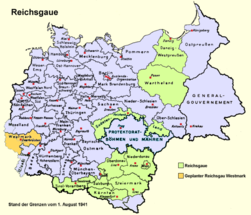
|
Administrative districts in territories under the control of Nazi Germany in 1941. Großdeutschland im Jahre 1941 |

|
Fascist concentration camps in Slovenia in WW2 |

|
Future Greater Slovenia in Greater Yugoslavia according to project of Stevan Moljević (1941) |
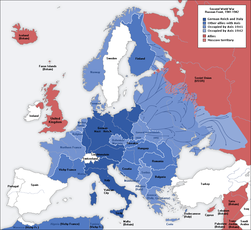
|
Eastern front of the Second World War circa 1941-1942. |

|
Free Territory of Trieste, 1947-1954 |

|
Free Territory of Trieste, 1947-1954 |

|
Istrian Littoral during 20th century and territorial gains of Slovenia in 1947-1954 |

|
Proposed division of Yugoslavia according to the Pavelić-Stojadinović agreement in 1954 |

|
Division of Socialist Federal Republic of Yugoslavia, showing location of Slovenia (number 1) |
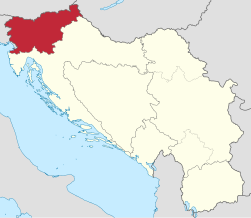
|
Slovenia in the Socialist Federal Republic of Yugoslavia |
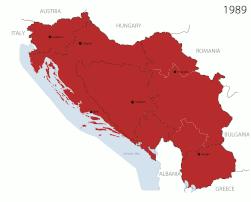
|
An animated series of maps showing the breakup of the second Yugoslavia |
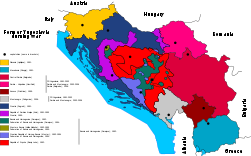
|
Wartime in former Yugoslavia in 1991 |

|
Slovenian war, 1991 |

|
Wartime in former Yugoslavia in 1992 |

|
Former Yugoslavia compared with the present borders |

|
Former Yugoslavia compared with the present borders |

|
Croatia-Slovenia maritime boundary dispute |
Satellite maps

|
Satellite map |
Other maps

|
Slovenian language |

|
Slovenian dialects |

|
Styria |

|
Istria |
Maps of divisions
This section holds maps of the administrative divisions.
-
Ajdovščina municipality
-
Apače municipality
-
Beltinci municipality
-
Benedikt municipality
-
Bistrica ob Sotli municipality
-
Bled municipality
-
Bloke municipality
-
Bohinj municipality
-
Borovnica municipality
-
Bovec municipality
-
Braslovče municipality
-
Brda municipality
-
Brezovica municipality
-
Brežice municipality
-
Cankova municipality
-
Celje municipality
-
Cerklje na Gorenjskem municipality
-
Cerknica municipality
-
Cerkno municipality
-
Cerkvenjak municipality
-
Cirkulane municipality
-
Črenšovci municipality
-
Črna na Koroškem municipality
-
Črnomelj municipality
-
Destrnik municipality
-
Divača municipality
-
Dobje municipality
-
Dobrepolje municipality
-
Dobrna municipality
-
Dobrova-Polhov Gradec municipality
-
Dobrovnik municipality
-
Dol pri Ljubljani municipality
-
Dolenjske Toplice municipality
-
Domžale municipality
-
Dornava municipality
-
Dravograd municipality
-
Duplek municipality
-
Gorenja vas-Poljane municipality
-
Gorišnica municipality
-
Gorje municipality
-
Gornja Radgona municipality
-
Gornji Grad municipality
-
Gornji Petrovci municipality
-
Grad municipality
-
Grosuplje municipality
-
Hajdina municipality
-
Hoče-Slivnica municipality
-
Hodoš municipality
-
Horjul municipality
-
Hrastnik municipality
-
Hrpelje-Kozina municipality
-
Idrija municipality
-
Ig municipality
-
Ilirska Bistrica municipality
-
Ivančna Gorica municipality
-
Izola municipality
-
Jesenice municipality
-
Jezersko municipality
-
Juršinci municipality
-
Kamnik municipality
-
Kanal ob Soči municipality
-
Kidričevo municipality
-
Kobarid municipality
-
Kobilje municipality
-
Kočevje municipality
-
Komen municipality
-
Komenda municipality
-
Koper municipality
-
Kostanjevica na Krki municipality
-
Kostel municipality
-
Kozje municipality
-
Kranj municipality
-
Kranjska Gora municipality
-
Križevci municipality
-
Krško municipality
-
Kungota municipality
-
Kuzma municipality
-
Laško municipality
-
Lenart municipality
-
Lendava municipality
-
Litija municipality
-
Ljubljana municipality
-
Ljubno municipality
-
Ljutomer municipality
-
Log-Dragomer municipality
-
Logatec municipality
-
Loška dolina municipality
-
Loški Potok municipality
-
Lovrenc na Pohorju municipality
-
Luče municipality
-
Lukovica municipality
-
Majšperk municipality
-
Makole municipality
-
Maribor municipality
-
Markovci municipality
-
Medvode municipality
-
Mengeš municipality
-
Metlika municipality
-
Mežica municipality
-
Miren-Kostanjevica municipality
-
Mirna Peč municipality
-
Mislinja municipality
-
Mokronog-Trebelno municipality
-
Moravče municipality
-
Moravske Toplice municipality
-
Mozirje municipality
-
Murska Sobota municipality
-
Muta municipality
-
Naklo municipality
-
Nazarje municipality
-
Nova Gorica municipality
-
Novo mesto municipality
-
Odranci municipality
-
Oplotnica municipality
-
Ormož municipality
-
Osilnica municipality
-
Pesnica municipality
-
Piran municipality
-
Pivka municipality
-
Podčetrtek municipality
-
Podlehnik municipality
-
Podvelka municipality
-
Poljčane municipality
-
Polzela municipality
-
Postojna municipality
-
Prebold municipality
-
Preddvor municipality
-
Prevalje municipality
-
Ptuj municipality
-
Puconci municipality
-
Rače-Fram municipality
-
Radeče municipality
-
Radenci municipality
-
Radlje ob Dravi municipality
-
Radovljica municipality
-
Ravne na Koroškem municipality
-
Razkrižje municipality
-
Rečica ob Savinji municipality
-
Renče-Vogrsko municipality
-
Ribnica municipality
-
Ribnica na Pohorju municipality
-
Rogaška Slatina municipality
-
Rogašovci municipality
-
Rogatec municipality
-
Ruše municipality
-
Selnica ob Dravi municipality
-
Semič municipality
-
Sevnica municipality
-
Sežana municipality
-
Slovenj Gradec municipality
-
Slovenska Bistrica municipality
-
Slovenske Konjice municipality
-
Sodražica municipality
-
Solčava municipality
-
Središče ob Dravi municipality
-
Starše municipality
-
Straža municipality
-
Sveta Ana municipality
-
Sveta Trojica v Slovenskih goricah municipality
-
Sveti Andraž v Slovenskih goricah municipality
-
Sveti Jurij ob Ščavnici municipality
-
Sveti Jurij v Slovenskih goricah municipality
-
Sveti Tomaž municipality
-
Šalovci municipality
-
Šempeter-Vrtojba municipality
-
Šenčur municipality
-
Šentilj municipality
-
Šentjernej municipality
-
Šentjur municipality
-
Šentrupert municipality
-
Škocjan municipality
-
Škofja Loka municipality
-
Škofljica municipality
-
Šmarje pri Jelšah municipality
-
Šmarješke Toplice municipality
-
Šmartno ob Paki municipality
-
Šmartno pri Litiji municipality
-
Šoštanj municipality
-
Štore municipality
-
Tabor municipality
-
Tišina municipality
-
Tolmin municipality
-
Trbovlje municipality
-
Trebnje municipality
-
Trnovska vas municipality
-
Trzin municipality
-
Tržič municipality
-
Turnišče municipality
-
Velenje municipality
-
Velika Polana municipality
-
Velike Lašče municipality
-
Veržej municipality
-
Videm municipality
-
Vipava municipality
-
Vitanje municipality
-
Vodice municipality
-
Vojnik municipality
-
Vransko municipality
-
Vrhnika municipality
-
Vuzenica municipality
-
Zagorje ob Savi municipality
-
Zavrč municipality
-
Zreče municipality
-
Žalec municipality
-
Železniki municipality
-
Žetale municipality
-
Žiri municipality
-
Žirovnica municipality
-
Žužemberk municipality
Notes and references
|
General remarks:
|
